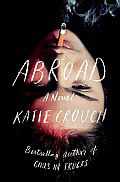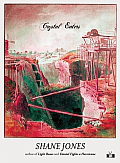Weston Cutter's Blog, page 9
July 10, 2014
Mortality Strikes Again
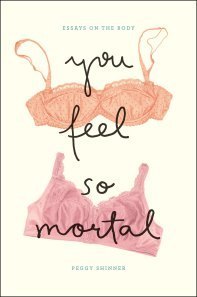 YOU FEEL SO MORTAL: ESSAYS ON THE BODY by Peggy Shinner
YOU FEEL SO MORTAL: ESSAYS ON THE BODY by Peggy Shinner
I’m so fucking glad University of Chicago Press finally published a collection of Peggy Shinner’s essays on the body. Except, though, I’m not glad it got published, like, in Chicago, for whatever reason (I don’t pretend I know the politics of this stuff), only because Shinner’s already a local legend and I need people outside this city to realize THIS LADY’S A LEGEND.
I love this book. You’ll love this book if you’ve ever looked at even one part of your body and thought why the fuck are you like that, or had trouble understanding even one idiosyncrasy of the particular brain inside you. God, these essays are so fucking fantastic, I greedily read them all in a day (even though, in reality, they’ve been parceled out, appearing in lit mags as earlier as 2000) and just KNOW I’ll be digesting them for a long long while to come.
As mentioned, every essay in here is unapologetically centered around the body. Of course, we springboard from there. Pieces about posture become about race in America; thoughts on autopsies summon religious beliefs; nose jobs relate into a man’s ability to function at a peak professional level.
Shinner, an outsider from the American ideal in many ways (Jewish, woman, lesbian), struggles with the way her body, this misshapen Jewish body of hers, fits into the larger context of the world in many essays.
Here are parts of her she feels oddly about and contributes to her race: Feet; posture; nose; inability to face cremation; unease with organ donation.
Here are parts of her she feels oddly about and contributes to being a woman: a tinge of kleptomania; decreased ability to defend herself; breasts; hair.
Here are parts of her she feels oddly about and contributes to her brain: desperation to feel unique; discomfort with being mildly depressed; being a lesbian; guilt about feeling oddly about her Jewish qualities; guilt about feeling oddly about her womanish qualities.
These stories, though, are amazing.
“Pocketing” reveals what I’ve always thought to be true, but never asked my friends: Don’t you just get the urge to steal things you could very well buy? Shinner’s stolen a few things from stores, something I’ve never been brave enough to do; any pocketing of mine has been from friends and families homes, which is probably worse. I only steal tiny tiny things, items I can put in a pocket like beads, trinkets or miniature figurines, sample squirt bottles of perfume, a perfect lipstick. Of course, once these items make it back to my house, I’m too guilty to ever touch them, never able to use or look at the objects, and then I go on beating myself up over taking the thing. What Shinner confirms: I am not insane for doing this. In fact, someone reading this is probably nodding her head (because it’s likely a woman) in agreement. Unlike some experts believe, kleptomania is not a sexual fetish; it’s an impulse-control issue. Much like picking a scab, we know it will never end well, but we must do it nonetheless.
“Berenice’s Hair” may be my favorite piece, despite it’s subdued, third-person tones. Tracing the mythologies and the rules surrounding womens’ hair for thousands of years, Shinner offers no advice on how to keep one locks, only a reiteration of what society has always told us. There is no telling who is right who is wrong; it’s plainly laid before us without comment.
“Postmortem,” the conclusion of the book, sees Shinner struggling to come to terms with the science and cultural significance of her father’s autopsy. When first asked if they elect for the procedure, she and her family accept. A funeral is had, and weeks later, Shinner learns doctors are still examining her father’s brain. Because it wasn’t buried inside him. None of his organs were. That’s just how autopsies are. But it’s funny – wouldn’t we know that? Why does that seem like new information? Do we hear that, nod, and promptly forgot because it’s too strange to imagine our skin, dressed in suits and silk dresses, going into the earth empty not just of soul, but of, really, all substance?
Maybe that’s what I love about You Feel So Mortal the most. Shinner raises these questions, probes around her own world, her own body, yet puts no judgment on ours. She does not dismiss you for having a nose job. She does not roll her eyes at your rock hard abs, posture of a princess. She looks at these fleshy, mortal bodies, realizes the fragility of these objects and does nothing to injury the spirit inside. Instead, we are only asked to wonder.


July 8, 2014
Say Yes to Everything
I SAID YES TO EVERYTHING: A MEMOIR by Lee Grant 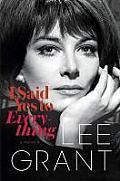
I didn’t even know how much I loved Lee Grant until I read this book.
Of course, I knew I liked her or thought she was cool, otherwise I would have looked over her autobiography, but all I knew about the girl was that she was amazing in In The Heat of the Night and I’m incredibly interested in basically any of the girls who were in The Valley of the Dolls.
And if that’s all you know about Lee Grant right now – believe me, this lady is way cooler than that.
Lee Grant wasn’t always Lee Grant. She was born, in a year frequently tinkered with on passports and driver’s licenses, as Lyova Haskell Rosenthal, but of course, that’s not a name to get the good roles with. The story starts with adorable insights into her girlhood, my two favorite being 1) being called precocious by adults and being so flattered because she thought they meant precious, and 2) having her first love as a child, only to see it end when her mother forced her to wear this certain dress.
Of course, it starts getting good when Lee breaks off on her own. She leaves the home of her parents and moves straight in with a man about 10 years her senior, already a father of three and already a suspected communist during the McCarthy era. Being a young actress linked to a suspected communist would have been, of course, death to a career, which makes it all the more fascinating that we still care about Lee Grant today.
After a suspect commie dies under circumstances that look very much like he was pushed to an untimely death by investigators, Lee says this at his funeral, and for the next 12 years, puts the nail in the coffin of her career. No one would hire her; there was no point going to auditions. In one story, Lee remembers getting a call from a young girl asking her to come audition, to which Lee replies she must be mistaken, the girl looks at her lists again, and apologizes, they have no work for her.
Was America really like this? Today, celebrities can spew off speeches of hate towards Obama and nothing prevents their next role.
When Lee’s name is finally cleared 12 years later, when the offers are finally coming in, it’s the parts of 20-somethings that people are interested in. So, in this time before IMDb, before the internet, she went lied about her birthday, claiming to the officials they’d made a grave error, marking her a ten years older than she was.
I swear it seems like I’m writing a review of a piece of fiction, like this is some story of a girl that’s too improbable to be true, too literate to be real life. I suppose that’s a bit of what I Said Yes to Everything feels like.
The blacklist lifted, Lee shares the details (and the dirt) of the movies she’s worked on, the directors and stars she’s worked with, the successes and the failures. She’s got a refreshing honesty – admitting the parts she took for money, admitting her own stubbornness looking back on events.
Actually, that’s one of the things I admire about this book most. As Lee says: “I write not anticipating what I’ll say. Sandy Meisner said, ‘Don’t anticipate, surprise yourself.’” And truly – Lee’s the first to admit the things that surprise her as she recounts. So many sentences start with “looking back,” and end with Lee coming to self-realizations of her own behaviors.
As she grew older, maturing in the industry, Lee couldn’t help but try her hand at directing, and I’m so glad she did. It’s probably a really insignificant part of her story for most, but I was intently drawn to her telling of the first documentary she’d directed, a film called Willmar 8 that captured the strike carried out by 8 Minnesotan women who had spent years teaching and training young men that would soon become their own bosses (when they confronted their boss on this, his response was “You are women, after all.”) It’s really a fantastic story of feminism and strong women, and, Willmar being my hometown (as well as the hometown of Lee Grant’s best friend), it’s a story I’ve only heard a different side of in school. I’d love to say the strikers were now revered as heroes, that the groundbreaking strike and the exposure from Lee’s film changed the landscape of women in the workplace in Willmar, but…
Can I keep going on and on over every insight shared by Lee, every detail of this story that stuck to me? It’s in the hundreds. I’m amazed at the honesty, the heart and humility found in I Said Yes to Everything, and I’m sure you will as well. If you’re not a Lee Grant fan already, read this, and you will be.


July 3, 2014
Pinewood Derby Cars are the Fucking Worst.
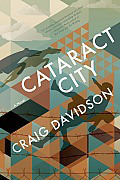 CATARACT CITY by Craig Davidson
CATARACT CITY by Craig Davidson
Where did this novel come from? Cataract City just blew me out of the water. You start books thinking you have some idea what’s going to happen, how the story will unwind, but with this one, literally, there’s no guarantee what the next page will look like.
The story starts off not all that originally. One friend picks up another from jail. There’s unspoken feelings between them. There’s tension, but we don’t know what it’s all about.
Switch back then, these men are just 12, becoming best friends over a mutual love for pro-wrestling players and a common boredom and restlessness that seems to be unavoidable in Cataract City, the nickname for the town on the Canadian side of Niagara Falls. The town hasn’t managed to capture an ounce of the Fall’s beauty. Instead, it’s a place that revolves around a factory, a few bars men retire to regularly, a sad worn strip-club and other meager attractions. It’s not so uncommon that two boys from different sides of the tracks – Owen “Dutchie” Stuckey from a white-collar family, Duncan Diggs from a blue – form this best friendship; it’s not so uncommon they drift apart, either.
True action starts at what seems the most boring of all places: a pinewood derby race. For those of you that didn’t grow up in the Midwest watching your dad and older brothers strategically paint and glue these little wooden cars together, or at least do it yourself, it’s hard to explain just how important this is in the life of a young Boy Scout. Who knows the actually “reason,” but it’s a big fucking deal. Like, some dads, the kind that were probably the captain of their high-school football team and haven’t found another adequate outlet for their competitive side since then, will spend weeks trying to figure out any trick to make cars a millisecond faster than the other snot-nosed kids.
Men: let’s just settle this now, pinewood derby cars prove NOTHING, not that you love your son more than the dad whose kid’s car came in last; not that you’re smarter than the whatever-color-collar dad you beat.
Of course, the men of Cataract City probably know this, but they still try to cheat. They’ll hide weights in secret holes on the car; they’ll shave the tires to their thinnest. They’ll do this without their sons knowing, kinda defeating the whole bonding / togetherness that the activity is supposed to teach. And then, when the races are over, they will literally get in fist-fights in the parking lot and literally have no other explanation for any of this than “that guy shaved the tires on his pinewood car.”
Yeah, it’s stupid. Even Owen and Duncan, 12 years old, realize this on some level. So when a man they look up to tells them to get in his van, that he’ll take them home while their dads duke it out, the boys don’t give it a second thought.
Cataract City is amazing because you think you know where this is going, but you have no idea. Expect 30 more turns.
The boys don’t stay in the van forever, even though, of course, they aren’t driven home. We don’t even know how long they’re gone, and once they’re found, the story isn’t even halfway over.
Owen and Duncan drift apart, Owen becoming the star basketball player of their high school, Duncan becoming this sensitive guy that rescues greyhounds out of dumpsters. Actually, it’s the greyhounds that bring the boys back together – Duncan finds two, can only keep one and trusts nobody more than Owen to raise this lost animal well.
But Cataract City stays in their bones, and here, old rivalries, like old loyalties, don’t die without a fight. There’s smugglers moving across the borders, women that moving from one friend to another, dogs dying to run, and pains waiting to heal. There’s too much of the city in their bones to put it behind.


July 1, 2014
Tell Us More, Everything
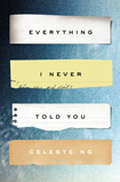 EVERYTHING I NEVER TOLD YOU by Celeste Ng
EVERYTHING I NEVER TOLD YOU by Celeste Ng
Celeste Ng’s Everything I Never Told You begins a lot like the first scenes of Twin Peaks. A pretty high-school student’s family goes through their morning routine, trying not to panic that their daughter is missing. Not in her room; not with the boy she’s been hanging out with early; not at the school early. Of course, what we know and they don’t: Their daughter is already dead in the lake.
Here’s maybe the biggest difference between the novel and Lynch’s show, though: Instead of being the popular, prom Queen blonde, this novel’s ill-fated star is Lydia Lee, a girl with no friends, seen only with a boy that everyone knows doesn’t love her, one of only two non-white students in the entire school (the other being her older brother, Nath). And also unlike Twin Peaks, no major investigation is launched, nobody from the police force really seems to care or even think this could be anything other than a suicide, maybe, unfortunately, because of her race.
It starts as a simple who-did-it, why, what’s-the-motive, and quickly becomes the story of many of the problems Americans want to think about the least – race, bullying, the role of a married woman, the role of a girl in the world.
From these unravelings, we get the stories of the rest of her family. Her mother, a white woman named Marilyn who was desperate to become another other than the cookie-cutter matrons she saw in her youth. Unaccording to plan, she fell in love and became pregnant before finishing her school with a man who, unaccording to her parents’ plans, was Chinese. To complicate the pain of the investigation of her daughter’s death, the police keep digging up the past dirt of Marilyn’s marriage, including the time she ran away from home, from her husband and children.
Her father, James, has always wanted to just fit in. It’s not easy being the only Asian in the room, or the only non-Caucasian person in town. He loves Marilyn, but there’s a part of him that wishes she could truly understand rather than just empathize. He knows it’s wrong, but after Lydia’s funeral, James begins an affair with his assistant, a young Chinese woman. It’s not a betrayal of his family; it’s something else entirely.
Nath, Lydia’s older brother cannot stop thinking about a time when the two were young. Even though he knew Lydia couldn’t swim (and until her teens, never showed any ability), in childhood frustration and envy, he pushed her out of the boat, only to pull her to safety moments later. Still, this action haunts him years later. Also haunting Nath is the suspicion Lydia’s boyfriend, or whatever you’d want to call that scum bag Jack, has more to do with Lydia’s death than the police are willing to acknowledge. Jack’s been tormenting Nath for years – wouldn’t it make perfect sense to hurt Nath by hurting his little sister?
Finally, there’s the youngest in the family, Hannah. So quiet you barely notice her in a scene. Her family often overlooks her tucked under a table, hearing their conversations and absorbing their secrets. Like a small mouse, the only remaining daughter is forgotten as those older than her deal with their own traumas.
It’s intense. It really is. There’s nothing you can say to make any of these characters feel better. Even though it’s set in the 70’s, you can’t help but feel these problems would look so tragically the same today, unfair as that all is.
It’s a masterful look into the struggles of growing up different, of living in a mixed-race family in a town and a time that doesn’t get it. It’s a beautiful tale of redemption, of suffering and forgiveness. Even if the end doesn’t have the solution you’d desire, you’re left a little bit better just having read along the whole time.


June 26, 2014
Foils and Folly
 Rufi Thorpe’s THE GIRLS FROM CORONA DEL MAR
Rufi Thorpe’s THE GIRLS FROM CORONA DEL MAR
There’s this horrible concept that girls suffer from in which they see themselves and their girlfriends and believe one of them is the leader, the rest are side characters. It’s not an amazingly new concept, and of course, boys do it as well (the classic first-to-mind example I’m thinking of is “The Simpsons” – Bart is the lead, Milhouse is a stupid foil character Bart knows is less important in the entire scheme of life), but really, in most pop culture, boys come in gangs with powers distributed, girls come with Queen Bees and her followers. Seriously – don’t you remember this scene from The Holiday? You’re a leading leader or you’re Judy Greer.
It’s a horrible thing to drill into girls’ psyche, though. As Kate Winslet figures out, YOU’RE supposed to be the leading lady of your own life. If your friends are casting you as the sidekick, making you the Milhouse, there’s a fucking problem with your power dynamics and your self-esteem.
In Rufi Thorpe’s amazing are-you-serious-this-is-a-debut novel The Girls from Corona Del Mar, this struggle between two best friends that grow from girls in mothers and wives to determine which one is the lead sits straight in the center of the drama.
Contender for the lead number one is Mia. She’s an obvious choice for the star, being the first-person narrator of the novel’s 250 or so pages. As girls, Mia plays the more troubled of the pair – between an alcoholic mother, an insensitive father, an abortion at 15 – it seems young life could easily revolve around Mia’s problems and her conquering adversity.
But then there’s contender two, Lolola Lorrie Ann, the kinder, more beautiful girl with what seems a much lighter, bigger heart. Mia’s jealous of the perfection found in Lorrie Ann’s family, the father that writes and sings songs about his daughter, the tightness of the brood and their seeming ability to sustain the best of times together, alone in their home. Even in Mia’s mind, Lorrie Ann is the natural star, Mia herself just a bit player, a foil to show how shitty some other girls’ lives are.
And it’s true – probably more than half of the pages, from girlhood on, revolve around the highs and lows of Lorrie Ann’s life. Of course, it is a life that derails before even graduating high school. Her father, the dad Mia’s infinitely jealous of, dies after an accident with a drunk driver. Just two years after Mia’s abortion, Lorrie Ann’s pregnant, and instead of getting rid of the baby, she decides to keep it and marry the father. Instead of becoming the perfect little starter family, Lorrie Ann’s little boy Zach is born mentally and physically disabled, unable to ever walk or tell his mother he loves her. Even though she could use the help, Lorrie Ann, under direction of her husband, begins to distance herself from Mia, who goes off to Yale.
It’s weird – even after years, Mia still sees herself as the antithesis rather than a protagonist. Lorrie Ann is, in her mind, a modern day Job, a woman who only does good, who only gets shit in return. Through the years, Lorrie Ann’s fortunes worsen and worsen, until she becomes a junkie, a gypsy, a wanderer and a partier moving from fix to fix. Crazy parties, too, most memorably in this paragraph which is by no means the most significant of the novel, but the one I just can’t seem to shake off:
In Hvar, a count, also a multimillionaire, had asked Lorrie Ann to marry him one night and she had even said yes, but then in the morning he didn’t seem to remember it and she didn’t bring it up, in part because a sloth, which had been rented from the zoo for the party, had somehow died during the night and the entire morning was like an extended game of Clue, all of them trying to piece together how the sloth had ended up floating in the pool with the side of its head bashed in. One of the girls, a former Playboy bunny, had had some kind of emotional breakdown over the sloth and did nothing but sit on a deck chair, cradling its wet dead body all morning as she wept into its fur. Finally, it had to be taken from her.
Rufi Thorpe – how do you come up with this stuff?? Who imagines anecdotes about dead sloths and the Playboy bunnies that love them?? Obviously – you can trust her with fiction and telling a wild and worthy story.
In the end, do we ever settle which girl it is/was that is/was the protagonist? Do we learn which girl is the foil?
If you finish this novel and still need an answer to this question, it’s very likely you’ve missed the entire point.
((End note: I feel like I wrote this review and was so focused on how deep and important the storyline is, I forgot to mention: It’s FAN-FUCKING-TASTIC. Even if you aren’t so intrigued by the ranking system of American females, read this because it’s a fan-fucking-tastic book.))


June 24, 2014
The Dark Place Abroad
How many favors has Katie Crouch done me already? First, and not vapidly – I support all girls named “Katie” and not Kate or Katherine in the lit world, because I hear you girl, I will not change my name to sound more sophisticated. Katies are sophisticated as hell. So first, thanks for that, girl. But more importantly: Crouch has given us the murder mystery of the summer in Abroad.
Is it a mystery, though? You know who’s going to die the whole time, at least once Tabitha, or Taz, starts inserting these creepy notes in her narration that go something like “After I died,” or “In the days after my funeral.” The first time it happened, I think I looked back around in the pages, thinking I must have missed something, must have entered some dream sequence, right? The mystery’s not a who-gets-it, but it how and why, which ultimately, becomes much darker than any old whodunit.
The story is based loosely (just HOW loosely, I’d have to research more) on the real-life murder of Amanda Know, a girl who was murdered in her Italian flat while studying abroad. Really, I know squat about the true story – I read like, one article in Rolling Stone that was fighting for the roommate’s innocence in the matter (she was still in jail at the time) and graphically described the murder scene (which it seems Crouch followed to a T), but I had no clue where things were going for the first 250 pages or so.
It starts out with a group of girls authorities didn’t know had a thing to do with the murder. Three girls, also in Italy for a study abroad semester, although they have the most terrible Italian and don’t seem too troubled or compelled to fix it, that put off the air of class, the image of wealth, of the grass greener. These are the girls that look like everything Taz isn’t: confident, sultry, spoiled. There’s Jenny, the cold leader who’s got crazy control over the group as well as her sexuality, taking home a new guy every night. Anna, the nervous one and maybe the only one actually interested in learning from the classes they take. And Luka, the artist in the group, a girl still trying to discover who she is and what that means.
It’s Jenny that approaches Taz, invites her into the group simply because they need a girl who speaks Italian better than the three of them. The contracts of their friendship are drawn up like a contract, stale and cool. Nevertheless, these are the most glamorous girls Taz could hope to hang out with. These are girls with access to the best parties, who take jaunts to Argentina or wherever they feel like, just to see an art retrospective or catch the party of the week. Taz is in no position to turn them down.
The girls aren’t her real friends, though, at least not in the way her American roommate Claire is. No one’s sure if it’s the American in her that makes her this way, or if she’s just insane, but Claire’s the wildest of anyone. She goes to bars alone. She’s gorgeous and sleeping her way around town the city, until she gives it up and falls for a professor. She does impulse shit like play guitar on the street corner for cash. Even though Claire is defiantly odd by the standard of the others, it’s Claire that Taz connects with the most, for better or worse.
There’s dark dark secrets around every corner in this novel. For every minute these girls spend in class, there’s ten more filled with lies and sex and drugs. And of course, in a nation with such deep history, such an intricate past, there are whole pockets of the dark the girls could never even imagine.
This isn’t your average tale of girls-gone-wild, your Bling Ring or Spring Breakers. It’s much darker than that.


June 19, 2014
Ye-Ye Girls Head North
 Heather O’Neill’s “The Girl Who Was Saturday Night”
Heather O’Neill’s “The Girl Who Was Saturday Night”
(Please start by playing the mood music below)
Heather O’Neill’s The Girl Who Was Saturday Night reads like a French film from the 1960’s in all the best ways.
Set in the cold of Montreal, in an area of cramped apartments where stray cats roam like queens, The Girl… makes the region seem far more romantic, far more Parisian than anything I’d imagine of Canada. Half the time, you’ll forget the setting, in no small part thanks to the main character’s reminders that they speak French almost exclusively. At every mention of sweaters, it’s hard not to think of black and white stripped, thin cotton pieces rather than thick wool counter pieces.
But even further than this, protagonist Nouschka Tremblay is perhaps the closest thing to a ye-ye girl I’ve ever met on the page. She’s the type of girl that captures the camera, or in this case, the paragraph, making every thing else seem an accessory to her in the scene. She’s the romantic, dreamy ever-girl, seducing the audience with the flick of an eyelash, making us laugh just dancing down the sidewalk. She is, perhaps, the most utterly enduring character created all year.
Of course, Nouschka is only part of the story, and in her mind, only one half of a person without her twin brother, Nicholas. According to Nouschka, Nicholas and she are the same person, two halves of a whole, even though to our eyes, the twins couldn’t be more different. Yes, they still live together at the age of 19, still cannot spend more than 24 hours apart, prattle on like gossipy best friends and (at least Nouschka, believes) share all of their deepest secrets. But for every piece of Nouschka that is dreamy, there’s a part of Nicholas that is dreary, dragging those around him down, bitching and moaning about things he cannot change and people he cannot help.
The two most important of those people are, of course, the twin’s parents. They only really know their father, the popular ‘70s folk singer Etienne Tremblay (think Bob Dylan meets Serge Gainsbourg, with all the Charlotte-Gainsbourg connotations attached). Since the twins were babes, they’ve been raised inside of the man’s spotlight, appearing on shows with him reciting highly practiced lines that would highlight the twin’s perceived preciousness and essentially, make the entire world fall in love with them. Off air, their father is less of a dream, too concerned with his artwork to put much concern into their young lives.
As far as there mother, they have little idea of the woman outside of what they’ve heard of her from there father’s songs. They know she was young when they met, and still young (15, I believe) when she delivered the twins. Too young to be a mother, really. She left when they were still children. It’s not something the twins, teenagers themselves, really fault her for, but the fact that after all those years, she hasn’t even tried to contact them hurts. When Nicholas has the opportunity to track her down, he takes it without telling Nouschka. This becomes the first big secret between the two, a crack in what Nouschka believes to be an unbreakable bond.
It’s not as if the twins don’t have their own lives. They are both accustomed to partying separately, perhaps going home with a stranger or a favored hookup, even if only to return hours later to sleep in their shared room. And Nicholas has gotten himself thrown in jail the time or two, and also become a father himself throughout the years (though an almost as absent one as his mother was).
But, it’s when Nicholas’ secrets about their mother start to come forward that Nouschka truly breaks off on her own. Too soon, she’s dating Raphaël, a troubled young man who’s familiar with a childhood in the spotlight, having once been a promising young ice skater himself. All the signs are there to warn Nouschka about the boy – for instance, he’s gotten his name in the papers for having 140 or so dogs living in his apartment – yet she still marries him at the tender age of 20. It’s precious and heart-rendering and would make you mad, if only Nouschka was not the perfect girl to carry out these injustices.
Really, though, the strength of the book itself is wrapped in the heart of Nouschka. It is impossible to not take the girl’s side of things, not matter how crazy those things may seem. It’s exactly the feelings I get watching Une Femme Est Une Femme or any other Jean-Luc Godard film – if O’Neill wasn’t able to convey the rich appeal, not just sexually, not just sentimentally or satirically, of this woman, the whole thing would fall apart. It’s the art in pulling it off, of creating that character so distinct I’d bet on her every time.


June 17, 2014
Deep in the Woods: Smith Henderson’ FOURTH OF JULY CREEK
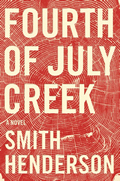 Smith Henderson’s “Fourth of July Creek”
Smith Henderson’s “Fourth of July Creek”
I have a really hard time stopping a book, tossing it aside for another once I begin. Especially as a reviewer, I hate this, because I’m sure I could get things done a lot faster if I was a little picker about my reading, but I don’t know. It’s like I’m thinking a bad book could have a good aftertaste, like a shitty wine, or some passage that just turned the table and made it all better, even though, 9 times out of 10, that doesn’t happen.
Why I’m saying this right now: I can’t even tell you how many times I wanted to put down Smith Henderson’s Fourth of July Creek, and it’s NOT AT ALL because it was bad or wasn’t well-written or any of the other reasons I usually throw books away. Basically, the reason I wanted to stop reading this book was that: it’s just SO intense.
But I couldn’t throw it away. Along with being so intense, the whole thing was SO REAL that it would be like hanging up mid-phone call with a crying friend – just because it’s hard for YOU doesn’t mean you can just bail. Otherwise, you’re just a weak-hearted asshole.
Did I simply finish this book not to be a weak-hearted asshole? Maybe. But also, I HAD to see if things could possibly end well. I HAD to know what the hell was going to happen.
To the story: It’s really set up with two main protagonists (although one gets significantly more pages), Department of Family Services agent Pete Snow and his 13-year-old-ish daughter Rachel, who would rather go by Rose.
You know those people that are like “It’s so funny that my job is X, because I simply suck at (a character trait related to X) in real life!” For instance: an accountant with massive credit card debt, or a marriage counselor who is divorced, or so on… You can probably get where I’m going with this: Pete Snow is a Department of Family Service agent who is divorced, with a daughter who has run away from her mother’s home, whose family is by all purposes, fucked up.
That’s not to say he’s bad at his job. He’s kind and generous to the children under his watch in the Montana wilderness, including a young man so messed up by his mother’s touches that he doesn’t know right from wrong anymore and another boy on the edge of manhood that’s mysterious wandered onto a schoolyard, without proper shoes or clothes, and bitten a teacher. It’s this second boy that Pete watches more closely, following him home and finding his gun-wielding, nearly mad father, a man named Jeremiah Pearl.
It’s this Jeremiah Pearl character that really steals the show. He’s a great part of the reason I couldn’t just stop this book, a novel that intricately describes the way this man’s son peels the skin off his calloused foot. Pearl’s got some crazy religious ideas about Christ coming back and the dollar losing its value and the only thing worth anything after that being actual gold and copper, but not the shitty stuff they’re making coins with these days. He’s also got the FBI watching his ass after getting his coins mixed up with some sketchy organizations that have gotten themselves under suspension after President Reagan is shot. It seems Jeremiah Pearl’s got everyone intrigued.
Alternatively, there’s Rachel (Rose), Pete’s daughter who’s moved to Texas with her mother and the woman’s scum of a boyfriend. In the very family that the DFS agent used to belong to, the teenage girl’s getting weird looks from her mother’s boyfriend, sneaking out, and making college-aged boyfriends. Soon, she’s had enough of this household and her mother and just runs away, doing whatever she can to make it along the way.
I mean, nothing so far is probably telling you just how raw and gross and painful this whole book is. Just the same, nothing I’ve told you has prepared you for the way this novel will suck you in, try to solve the story in your own mind.
It’s not a book I’d ever recommend to a friend as a beach read, or something for the plane or vacation, because I’d never want to read something so stressful under those circumstances, but if you’re looking for a gripping, intense family drama, Fourth of July Creek is it.


June 14, 2014
Ulysses Aside…
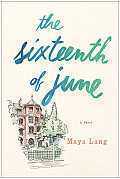 Maya Lang’s “The Sixteenth of June”
Maya Lang’s “The Sixteenth of June”
The Sixteenth of June is dedicated to “all the readers who never made it through Ulysses (or haven’t wanted to try),” which basically means Maya Lang dedicated this book to me. 250-ish pages, I can read this without dedicating, like a month’s worthy of Saturdays to the endeavor, as I would have to do with Joyce’s novel. Really, the entirety of The Sixteenth takes place over the course of one day (6/16/2004), and it’s not hard to say you’ll probably consume this book in a similar amount of time.
WHY haven’t I read Ulysses? It’s not even that I ‘haven’t wanted to try,’ it’s just that I haven’t gotten to it yet. Which sounds like a pathetic excuse from the girl who has now read the unabridged version of Les Miserables three times, but hey, all those reads were important, too. And I’ve read other Joyce – The Portrait of the Artist as a Young Man, most notably – but never saw the genius others raved about.
That said, even thought the book is dedicated to those of us who haven’t gotten through Ulysses, I have this uncomfortable feeling that I’m just, not understanding the “Importance” of what is going on, or the parallels or the allusions or anything else. I hope Lang wouldn’t be that mean. I think perhaps this book really isn’t in any sort of conversation with Ulysses besides the fact they both take place on this “Bloomsday” (which, I don’t know what that means) and maybe both talk about struggling and yearning and passion and convention and all those touch points.
The story centers around three young people, a pair of brothers and the girl they both love in different ways. Stephen, the oldest, is a graduate and has been for awhile; his younger brother Leo, the easy-going one of the bunch who hates confrontation, drawing things out, and the like; and Nora, a beautiful but fragile singer, Stephen’s best friend for a number of years, now Leo’s fiancé (although they’ve yet to set a date for the wedding).
Of course, Bloomsday comes at a significant turning point in all of their young lives. First off, before the boy’s parents can celebrate their annual Bloomsday party (parties are, after all, a massive deal for the boy’s mother June), there’s a funeral for their grandmother in the morning. It sounds gross to have an unrelated party on the night of your mother’s funeral, yeah? It kind of is. But, the folks weren’t that close to the grandmother; they stuck her in a home, maybe prematurely, and never visited. Stephan, it turns out, is the only one that bothered to look in on her.
The morning of the funeral finds Stephan in an awkward position with his brother and Nora as well. Basically, he doesn’t want the two to get married. He loves his little brother, of course, but cannot understand what Nora sees in him. It’s not that he’s in love with Nora. On the contrary – on this day, he is in fact coming to terms with his own asexuality (his mother, on the other hand, is praying for him to be gay. All her friends have a “cause” they throw parties around and become martyrs for; she would LOVE a gay son and the subsequent coming-out balls. This detail is the most hilarious page of the novel, easily).
And what’s wrong with Nora? She’s just so… out of it. Floaty. She’s just missed the chance for a great Opera career, choosing instead to watch her mother battle chemotherapy. Now, with her mother gone and her career as well, there’s little left for her to grasp onto besides her impending marriage. Except she’s still hesitant to set a firm date for that, either.
I don’t know, any of you that have read Ulysses recognize the story line? It read breath-fresh and dramatic and exciting to me, with more of the urgency of a Virginia Woolf piece that what I have read of Joyce.
Whatever the case, this book stands alone. It’s a rush of energy and light and philosophy all original, and a great summer read. I don’t know if I could say the same about Joyce. These seems like a better novel to pack for my vacation.


June 12, 2014
Eat a Crystal
“Crystal Eaters” by Shane Jones
Crystal Eaters is set in a world where what doesn’t kill you does not make you stronger, it simply brings you closer to death. Babies are born, like video-game stars with a set number of crystals, a countdown from 100 as a baby to 0, when you die. Crystals are lost whenever a person gets hurt. Break an arm, lose maybe 5. Hit by a car, maybe 75, which means, if you were still young enough to have a high count, you’d survive, but with the knowledge you only have so many crystals left and will more than likely die decades before your friends, even though the injury itself fades.
The way this all made sense to me was through a video game my brother used to play called “Super Smash Bros.,” where the object of the game was to pummel your opponent until all his life points ran out. You could survive on just 5 life points for minutes, or get knocked out in two mega-punches in under a minute, which is what usually happened to me. I say my brother played this game because really, I hated it. Countdown until you just die. I was more interested in the games where you collected coins or stars or eggs or whatever, making points by stocking up on lives rather than taking it away from others.
Maybe it’s this attitude in me that made it so easy to connect to the two siblings at the heart of Crystal Eaters, Remy and Adam. Remy’s a girl somewhere younger than a teenager, between that age where a girl pulls away from her parents seeing the flaw in all their ways, yet somewhere older than a child, having the freedom to roam her village, keep secrets from her family and realize the permanence of mortality.
Her older brother Adam, more often referred to as Pants, is in jail because of his allegiance to a mysterious gang that believed in the powers of twinning – the alchemy of doubling your crystals, doubling your life – and of mysterious Black crystals, a type that can be eaten and add to your crystal count, if only anyone could find them and prove they exist.
Soon enough, Remy becomes just like her older brother, obsessed with finding Black crystals and finding a cure for death. Her father tells her this is futile, life is life, 100 is 100 until it’s 0. But Remy can’t sit still. Her mother’s come down with an illness that makes her lose crystals each day, throwing them up in a glittery slush. Remy can’t sit and watch her mother die, even if the obsession with giving her life is what landed her brother in jail.
At the same time, in the city nearby their village, buildings are growing on their own, popping up one in front of the other while construction workers sleep. And the sun is about to run into the earth.
This is the first of Shane Jones’ books I’ve read, and I found the entire thing so utterly gorgeous and weird and human and devastating. There wasn’t too much I knew about the guy going in – just that his past books have been, surprise surprise, just as complimented for their gorgeousity (a term I coined just now) and even optioned by director Spike Jonze (personally, I WANT WANT WANT Crystals Eaters to get optioned and then adapted by Lars von Trier (Melancholia, Nymphomaniac), the visualist whom Jones’ writing most closely read like in my mind).
I’ve since heard comparisons of Jones to Wes Anderson based on the preciousness of their work, their visual tics and general way of selling you the same cake time after time, after each turn, taking out a little more of the ingredients and using a little more frosting to make up for the missing volume (a metaphor I’m borrowing from my friends at Front Psych). Perhaps I wouldn’t have loved this novel as much if I’d read everything else from Jones first; but in the same way, we can test you time and again and ask if you’d have loved Royal Tenenbaums as much if it had come out in late 2013. Is the first taste the best? Could the next be as good? It’s something I’ll have to figure out reading more of Jones (which, for the record, I definitely definitely will).
For now, though, especially for those of you without a taste of Jones already on your palates, read this book.
The entire time, I’m reading this thing, which to mention, reads like a countdown, starting with the pages up high working down to page 1 (same with chapters), just wanting to take Remy into my arms and hold her and cry with her and try and try any desperate act to help her keep her mother alive, all of which, her father fails to do. I just want to help Adam in his escape from the jail, an escape his friends plan as “a jail break in reverse,” what exactly the hell that means, who knows, and bring him back to his mom and sister and keep them together. And even though we don’t get to see much compassion with the character, I want to go back in time with their dad, find where he lost the crystal that contained his sense of hope and restore it to the man who seems to have given up wishing.
Mostly, though, I want to help the children raise the count of crystals, want to make it possible for them to live in a world where you collect the coins rather than lose them.



